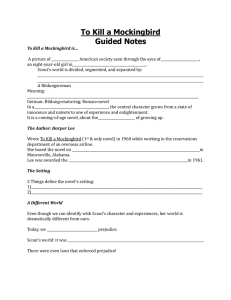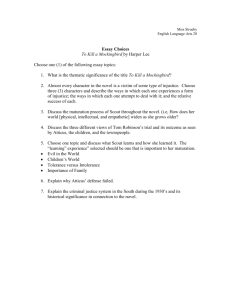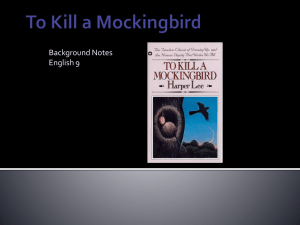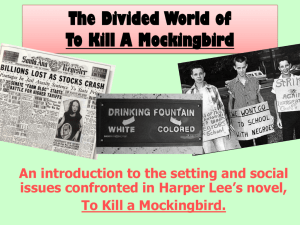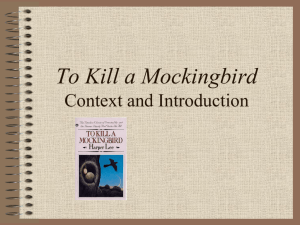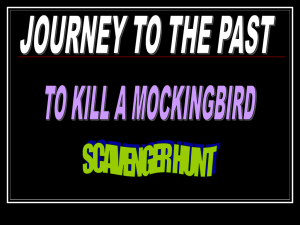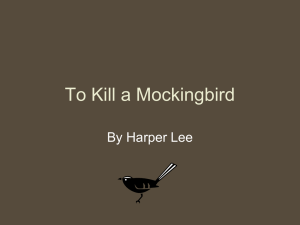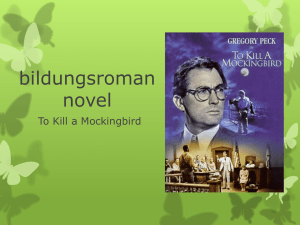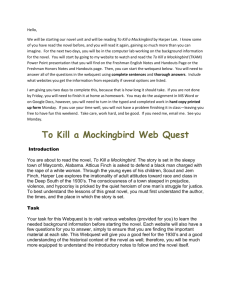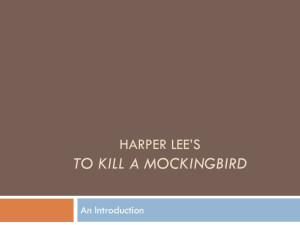The Divided World of To Kill A Mockingbird
advertisement
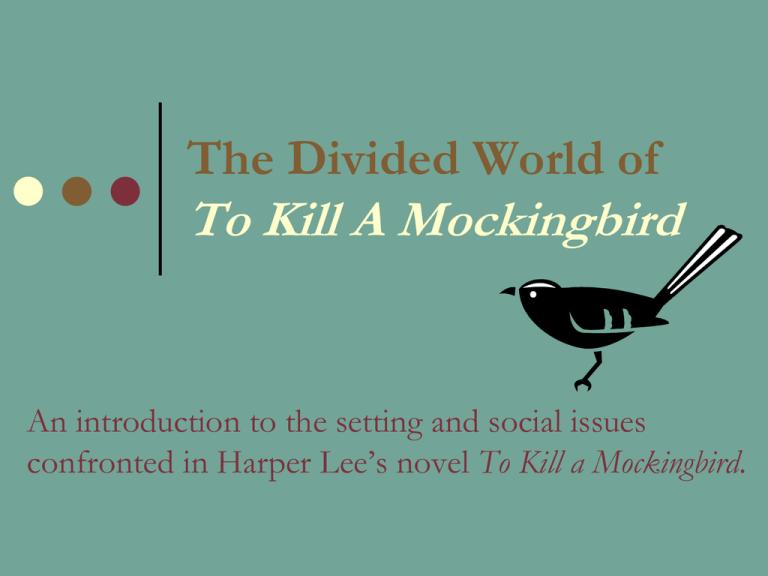
The Divided World of To Kill A Mockingbird An introduction to the setting and social issues confronted in Harper Lee’s novel To Kill a Mockingbird. To Kill a Mockingbird is . . . A picture of American society seen through the eyes of Scout Finch, an eight-year-old girl in Maycomb, Alabama. Scout’s world is divided, segmented, and separated by: social class, race, gender, and age. To Kill a Mockingbird is . . . A Bildungsroman Meaning: A novel of growing up & maturing German: Bildung=maturing; Roman=novel In a Bildungsroman, the central character grows from a state of innocence and naïveté to one of experience and enlightenment. It is a coming-of-age novel, about the journey of becoming an adult. The Author: Harper Lee She wrote To Kill a Mockingbird, her first and only novel, in 1960 while working in the reservations department of an overseas airline. She based the novel on her experiences growing up in Monroeville, Alabama. Lee was awarded the Pulitzer Prize for Fiction in 1961. The Setting Two things define the world of the novel: The American South The Great Depression of the 1930s A Different World: Prejudice Even though we can identify with Scout’s character and experiences, her world is dramatically different from ours. Today, we discourage prejudice—in Scout’s world, it was assumed, acknowledged, and encouraged. There were even laws that enforced prejudice! Jim Crow Laws The Jim Crow Laws were a racial caste system (a system that separates people into levels of society) that operated primarily but not exclusively in southern and border states from 1877 through the 1960s. Many states could impose legal punishments on people for consorting (having social contact) with members of another race. Laws forbade interracial marriage. Laws ordered business owners and public institutions to keep black and white clients separated. Examples of Jim Crow Laws African Americans were not allowed to vote. All interaction between races was restricted. • Water fountains • Door entrances & exits • Separate hospitals, churches, prisons and public schools • Separate public restrooms • In all instances these separate accommodations were inferior to those given to Caucasians. In some cases, there were no facilities offered at all. The Use of the “N” Word It should be no surprise that novel set in the racist atmosphere of 1930s Alabama contains repeated use of the “N” word. It is right to feel uncomfortable with this word. The use of this word does NOT mean that Harper Lee was racist. In a novel about tense racial and social issues in the 1930s south it is Lee’s responsibility to correctly reflect the beliefs and language of the people she is writing about. A Different World: Social Life In Scout’s hometown, there are specific social expectations. Children must be very polite to all white adults. Any adult has the right to scold and/or punish any disrespectful child. People must be friendly and hospitable. On Sundays, neighbors visit each other; it’s rude to have your doors closed, as that looks like you don’t want to socialize. Everyone goes to church. Men work to support their families; women stay at home, care for their families, & visit friends. Anyone who doesn’t do these things is viewed with suspicion. Social Class Hierarchy in Maycomb, Alabama “Somewhere I had received the impression that Fine Folks were people who did the best they could with the sense they had, but Aunt Alexandria was of the opinion . . .that the longer a family had been squatting on one patch of land the finer it was” (130). Families with hereditary links to the original settlers of Maycomb County Farmers & Professionals Ewells’ level of society “The Disgrace of Maycomb” Minorities (Jim Crow Laws & Racist society) A Comfortable World Even though Scout’s world may sound stifling and cruel, there are many good things about it, too: Neighbors help one another through tough times. The community is close-knit; everybody knows everybody else’s business, but they also care about each other. There are people who don’t share their community’s prejudices and who fight against them. A “Outside” World: The Great Depression A depression is a period of drastic decline in an economy, with less business activity, falling prices (so people don’t make as much money) and high levels of unemployment. The Great Depression in America began with a stock market crash in 1929 and didn’t end until 1941. Millions of people who once had enough money were now poor. People who had been poor became only poorer. Life in the Depression Because of the Depression, some children in Scout’s class at school have no food to bring for lunch and no money to buy one. Many children can’t pass the first grade because every year they have to leave school to help their families with the farming. Some of her father’s law clients can’t pay him in money; instead, they give him things from their farms—such as firewood. A poor farmer’s wife and child. A poor man’s transportation Movie theater in an Alabama town. A highway signboard: “Less TaxesMore Jobs” A typical downtown area. A street like the one Scout lives on. Maycomb, Alabama This is the world we enter in To Kill a Mockingbird—the world of the Finch family: eight-year old Scout, her twelve-year-old brother Jem, their black cook Calpurnia, and their father, Atticus Finch, a lawyer in the town.
